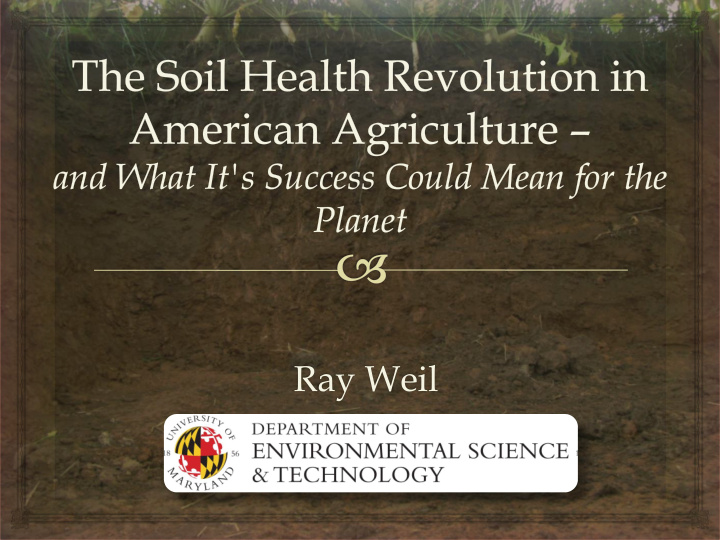



Ray Weil
Main Points Soil Health is Key to Sustainability: Physical/Chemical/Biological Cover Crops : Tools for sustainability Ag Revolution : new interest in / applications of soil health lead by “rock star farmers” Positive Environmental Impacts : Carbon sequestration, energy efficiency, clean water, better food, fewer chemicals
Farmer = Ecologist. Managing Millions of “Moving Parts”: both above and below ground 1. Plants: Crops , forages , green manures, weeds. 2. Animals: Cattle, wildlife, soil fauna. 3. Microbes: Pathogens, soil food web 4. Physical /chemical environment: Weather, soil structure, texture, pH, fertility.
Keystone Species: a Dung Beetle Typical dung beetle in cow manure Buries manure Conserves Nitrogen and other nutrients
Earthworms - Ecological engineers Photo by Steve Groff
Anecic earthworms under no-till: reconnecting topsoil and subsoil CANSIS
The Actors : Meso-fauna Heat source Soil core Cold water
Bacterivore Nematodes play Omnivore diverse roles within the food web Plant Parasitic Plant parasite Fungivore Predator Photos: Lisa Stocking Gruver, U of Md
The Soil Food Web Matters! From Omay, et al. 1998.
Wheat root covered with rhizobacteria Plant – microbe partnerships Margaret McCully.
Microorganisms: Fungi • Acid conditions • Untilled soil - Residues on surface • Woody, resistant materials
A Healthy Soil Will…. Absorb , hold and release water Breath -- exchange gases Cycle nutrients - mineralization Assimilate carbon into humus Resist raindrop erosion Allow root penetration Suppress pathogens Sustain genetic diversity
Soils from the rotation plots after drying. 25 yrs of 20 yrs of conventional bluegrass, then 5 tillage corn. yrs conventional 1.2 % SOM corn. 2.0% SOM
Organic v Conventional: False Choice The agricultural cropping efficiency (ACE) The agricultural cropping efficiency (ACE) coefficient is defined as the total sweet corn yield per unit of pollutant lost, with greater coefficient values indicating higher yields with less pollution. Normalized to No- Till/Conventional ENVIRONMENTAL IMPACTS SWEET CORN EROSION TOTAL TOTAL (SEDIMENT DISSOLVED PRODUCTION SYSTEM PHOSPHORUS (North Carolina) LOSS) NITROGEN 2011 2012 2011 2012 2011 2012 CONV TILL /Conventional 2b 6c 6c 17b 16b 24 CONV TILL /Organic 4b 10b 4c 9b 14b 44 NO-TILL /Organic 37a 16b 14b 11b 26b 33 NO-TILL /Conventional 100a 100a 100a 100a 100a 100 P value <0.001 <0.001 <0.001 <0.001 <0.05 >0.05 Edgell, J., D.L. Osmond, D.E. Line, G.D. Hoyt, J.M. Grossman, and E.M. Larsen. 2015. Comparison of surface water quality and yields from organically and conventionally produced sweet corn plots with conservation and conventional tillage. J Envir Qual.
Cover crops can utilize otherwise wasted resources Harvest Planting The sun shines, the rain falls and microbes work 10-12 months a year, but this typical Indiana grain farm captures only 3-4 months of this activity.
Cover Crops Liberate Farmers from Market Dictates on What to Plant 1. Cool season 4. Warm season grasses grasses 2. Cool season 5. Warm season Legumes legumes 3. Cool season 6. Warm season Brassicas broadleaves
By increasing bio-diversity and keeping living roots in the soil year- round …. Reduced Soil Cover erosion loss Increased Cover infiltration Soil crops Aggregation Soil Reduced temperature evaporation Food Weed web suppression Labile C activity Enhanced Soil Rhizobial Soil crop water Bio-drilling associations organic growth matter Nematodes Mycorrhizal associations P- fertility Nutrient capture Nitrogen Reduced leaching (N, P, S, K, etc) fertility loss (N)
Comparison on PA farm of Steve Groff, a leading no-till Following winter cover crop cover cropper. No winter cover crop Water dynamics: usually bio-drilling combined with surface mulch can be a water life saver during summer!
Cover crops can improve structure deeper in the soil
Reclaimed polder with calcareous sandy loam (30% silt, 5% OM) dug 60 cm deep, compacted and planted to perennial ryegrass. Compaction tripled plant parasite nematodes (herbivores) but didn't change total nematodes Bouwman, L.A., and W.B.M. Arts. 2000. Effects of soil compaction on the relationships between nematodes, grass production and soil physical properties. Applied Soil Ecology 14:213-222.
Bio-drilling- the cover crop answer to compaction Investigating roots with fiber optic camera: minirhizotron
Roots of corn following rye, radish or no winter cover Compacted crop layer Plow depth 45 cm 2 Chen and Weil, unpublished
Another major cover crop function: enhanced nutrient management Reduce losses Enhance availability Add nitrogen Recover deep nutrients
Nutrient capture: nitrogen in fall
By March-April, radishes are long dead and its residue is mainly gone, but its nitrogen capture effects are still evident. Unpublished data of Weill and Fisher
8 16 7 Fresh spinach, Mg/ha Roto tilled 14 6 No-till 12 5 Organic no-till, 10 4 no-herbicide 8 3 veggies using 6 2 cover crops 4 1 2 0 0 No cover Oat Radish Rad + Oat Lounsbury, N.P., and R.R. Weil. 2015. No-till seeded spinach after winterkilled cover crops in an organic production system. Renewable Agriculture and Food Systems 30:1-13.
Nitrogen captured in fall can reduce the need for fertilizer in spring No-till corn, after radish cover crop No-till corn, after rye cover crop
Example of more advanced cover cropping: Zoned cover crop mixtures Photo by Natalie Lounsbury
Thank-you! Any questions?
Recommend
More recommend